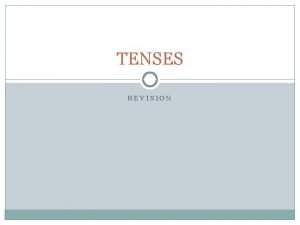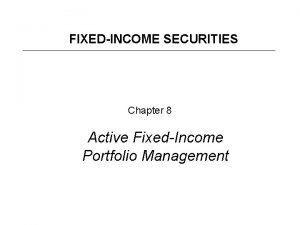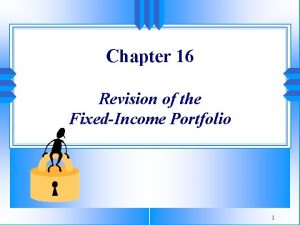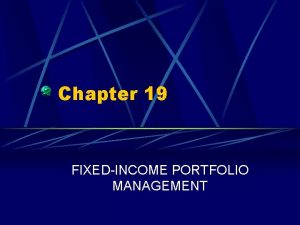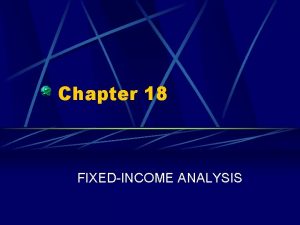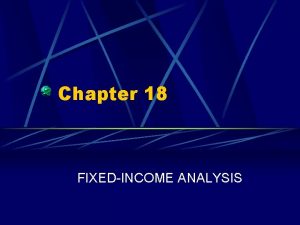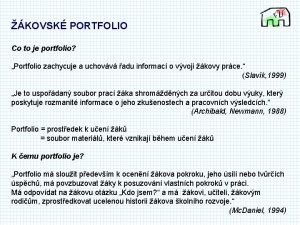Chapter 16 Revision of the FixedIncome Portfolio 1





































































- Slides: 69

Chapter 16 Revision of the Fixed-Income Portfolio 1

Outline u Introduction u Passive versus active management strategies u Duration re-visited u Bond convexity 2

Introduction u Fixed-income security management is largely a matter of altering the level of risk the portfolio faces: • Interest rate risk • Default risk • Reinvestment rate risk u Interest rate risk is measured by duration 3

Passive Versus Active Management Strategies u Passive strategies u Active strategies u Risk of barbells and ladders u Bullets versus barbells u Swaps u Forecasting interest rates u Volunteering callable municipal bonds 4

Passive Strategies u Buy and hold u Indexing 5

Buy and Hold u Bonds have a maturity date at which their investment merit ceases u. A passive bond strategy still requires the periodic replacement of bonds as they mature 6

Indexing u Indexing involves an attempt to replicate the investment characteristics of a popular measure of the bond market u Examples are: • J. P. Morgan Government Bond Index • Barclays Capital U. S. Aggregate Bond Index 7

Indexing (cont’d) u The rationale for indexing is market efficiency • Managers are unable to predict market movements and that attempts to time the market are fruitless u. A portfolio should be compared to an index of similar default and interest rate risk 8

Active Strategies u Laddered portfolio u Barbell portfolio u Other active strategies 9

Laddered Portfolio u In a laddered strategy, the fixed-income dollars are distributed throughout the yield curve u For example, a $1 million portfolio invested in bond maturities from 1 to 25 years (see next slide) 10

Par Value Held ($ in Thousands) Laddered Portfolio (cont’d) Years Until Maturity 11

Barbell Portfolio u The barbell strategy differs from the laddered strategy in that less amount is invested in the middle maturities u For example, a $1 million portfolio invests $70, 000 par value in bonds with maturities of 1 to 5 and 21 to 25 years, and $20, 000 par value in bonds with maturities of 6 to 20 years (see next slide) 12

Par Value Held ($ in Thousands) Barbell Portfolio (cont’d) Years Until Maturity 13

Barbell Portfolio (cont’d) u Managing a barbell portfolio is more complicated than managing a laddered portfolio u Each year, the manager must replace two sets of bonds: • The one-year bonds mature and the proceeds are used to buy 25 -year bonds • The 21 -year bonds become 20 -years bonds, and $50, 000 par value are sold and applied to the purchase of $50, 000 par value of 5 -year bonds 14

Other Active Strategies u Identify bonds that are likely to experience a rating change in the near future • An increase in bond rating pushes the price up • A downgrade pushes the price down 15

Risk of Barbells and Ladders u Interest rate risk u Reinvestment rate risk u Reconciling interest rate and reinvestment rate risks 16

Interest Rate Risk u Duration u The increases as maturity increases increase in duration is not linear • Malkiel’s theorem about the decreasing importance of lengthening maturity • E. g. , the difference in duration between 2 - and 1 -year bonds is greater than the difference in duration between 25 - and 24 -year bonds 17

Interest Rate Risk u What this means is that the barbell strategy has a lower duration than the laddered strategy. u Why is that? 18

Interest Rate Risk (cont’d) u Increasing interest rates favor a barbell strategy because while rising rates cause bond prices to go down, the barbell goes down less thanks to its lower duration/sensitivity. 19

Interest Rate Risk (cont’d) u Declining interest rates favor a laddered strategy because while declining rates cause bond prices to go up, the laddered goes up more thanks to its higher duration/sensitivity. 20

Reinvestment Rate Risk u The barbell portfolio requires a reinvestment each year of $70, 000 par value u The laddered portfolio requires the reinvestment each year of $40, 000 par value u Therefore rising interest rates favor the barbell strategy because more money gets re-invested at a higher rate. u Conversely, declining interest rates favor the laddered strategy because less money gets reinvested at a lower rate. 21

Reconciling Interest Rate & Reinvestment Rate Risks u The general risk comparison: Rising Interest Rates Falling Interest Rates Interest Rate Risk Barbell favored Laddered favored Reinvestment Rate Risk Barbell favored Laddered favored 22

Reconciling Interest Rate & Reinvestment Rate Risks u The relationships between risk and strategy are not always applicable: • It is possible to construct a barbell portfolio with a longer duration than a laddered portfolio – E. g. , include all zero-coupon bonds in the barbell portfolio 23

Bullets Versus Barbells u. A bullet strategy is one in which the bond maturities cluster around one particular maturity on the yield curve u It is possible to construct bullet and barbell portfolios with the same durations but with different interest rate risks • That is because duration only works when yield curve shifts are parallel 24

Bullets Versus Barbells/Laddered (cont’d) u. A heuristic on the performance of bullets, barbells and laddered strategies: • A barbell strategy will outperform a bullet or laddered strategy when the yield curve flattens • A bullet or laddered strategy will outperform a barbell strategy when the yield curve steepens 25

Bond Swaps u Purpose u Substitution swap u Intermarket or yield spread swap u Bond-rating swap u Rate anticipation swap 26

Purpose u In a bond swap, a portfolio manager exchanges an existing bond or set of bonds for a different issue 27

Purpose (cont’d) u Bond swaps are intended to: • Increase current income • Increase yield to maturity • Improve the potential for price appreciation with a decline in interest rates • Establish losses to offset capital gains or taxable income 28

Substitution Swap u In a substitution swap, the investor exchanges one bond for another of similar risk and maturity to increase the current yield • E. g. , selling an 8% coupon for par and buying an 8% coupon for $980 increases the current yield by 16 basis points since 80/980=8. 16%. 29

Substitution Swap (cont’d) u Profitable substitution swaps are inconsistent with market efficiency u Obvious opportunities for substitution swaps are rare, particularly in today’s increasingly fast trading environment. 30

Intermarket or Yield Spread Swap u The intermarket or yield spread swap involves bonds that trade in different markets • E. g. , government versus corporate bonds, or corporate AAA bonds versus BBB/CCC bonds. u Small differences in different markets can cause similar bonds to behave differently in response to changing market conditions 31

Intermarket or Yield Spread Swap (cont’d) u In a flight to quality, investors become less willing to hold risky bonds • As investors buy safe bonds and sell more risky bonds, the spread between their yields widens • This is because the price of risky bonds goes down (so their yields go further up) and the price of safe bonds goes up (so their yields go further down), so the difference in their yields widens. 32

Confidence Index u Flight to quality can be measured using the confidence index, which is the ratio of the yield on AAA bonds to the yield on BBB bonds. u This is because riskier (BBB) bonds have higher yields that go even higher during a flight to quality and safer (AAA) bonds have lower yields that go even lower during a flight to quality; the ratio thus goes down during a flight to quality 33

Rate Anticipation Swap u In a rate anticipation swap, the investor swaps bonds with different interest rate risks in anticipation of interest rate changes • Interest rate decline: replace short-term premium (high-coupon) bonds with long-term discount (lowcoupon) bonds so as to maximize the interest rate sensitivity/duration. • Interest rate increase: replace long-term discount (low-coupon) bonds with short-term premium (high -coupon) bonds so as to minimize the interest rate sensitivity/duration. 34

Volunteering Callable Municipal Bonds u Callable bonds are often retied at par as part of the sinking fund provision u If the bond issue sells in the marketplace below par, it is possible: • To generate capital gains for the client • If the bonds are offered to the municipality below par but above the market price 35

Properties of Duration u We already saw that the concept of duration can be seen as a time-weighted average of the bonds discounted payments as a proportion of the bond price, or as a weighted average of the cash flows “times”. u Duration can also be interpreted as a risk measure for bonds, however. 36

37

38

39

Example: Bond A has a 10 -year maturity, and bears a 7% coupon rate. Bond B has 10 years left to maturity, and a coupon rate of 13%. The current market interest rate is 7%. The price of bonds A and B are $1, 000 and $1, 421. 41 respectively. What happens to these prices if the market rate changes from 7% to 7. 7% ? 40

Answer: 41

Duration of a Portfolio of Bonds u The duration of a portfolio of Bonds is the weighted average of the durations of the individual assets making up the portfolio. u Proof: suppose you hold n 1 units of Bond 1 and n 2 units of Bond 2. Let B 1 and B 2 be the prices of the two bonds, and let D 1 and D 2 be their respective durations. 42

Mathematical proof 43

Bond Convexity u The importance of convexity u Calculating convexity u General rules of convexity u Using convexity 44

The Importance of Convexity u Convexity is the difference between the actual price change in a bond and that predicted by the duration statistic, in other words it is related to the amount of curvature in the bond pricing function. u In practice, the effects of convexity are relevant if the change in interest rate level is large. 45

The Importance of Convexity (cont’d) 46

The Importance of Convexity (cont’d) Bond Price Greater Convexity Yield to Maturity 47

The Importance of Convexity (cont’d) u As a bond’s yield moves up or down, there is some divergence from the actual price change (curved line) and the durationpredicted price change (tangent line) • The more pronounced the curve, the greater the price difference • The greater the yield change, the more important convexity becomes 48

Bond Price The Importance of Convexity (cont’d) Error from using duration only Current bond price Yield to Maturity 49

General Rules of Convexity u There are two general rules of convexity: • The higher the yield to maturity, the lower the convexity, everything else being equal • The lower the coupon, the greater the convexity, everything else being equal 50

Example u Recall the previous immunization example. u Bond 2 (asset) has the same duration as the liability. u However, there are other ways to select a portfolio of assets with a duration matching the liability’s duration. 51

Calculating Convexity DB(r) change in a B bond’s price associated with a change in the bond’s yield (r) can be approximately calculated as: u The u DB(r) = (d. B/dr) (Dr) + (1/2) (d 2 B/dr 2) (Dr)2 52

53

Building Portfolio of given Duration u Instead of using Bond 2 (with duration of 10) to match the obligation’s liability, let us build a portfolio made up of bond 1 and 3. u We want duration =10, therefore we need: u w. D 1+(1 -w)D 2=10, (D 1=7. 665 and D 2=14. 636) u This implies w=0. 66509 54

If interest rates change to, say, 7%: The Portfolio’s payoff remains more or less intact, just like Bond 2, and would thus allow us to meet the $ 1, 790. 85 obligation. 55

56

Bond 2 vs. Portfolio u The last slide’s graph of Terminal values shows that both Bond 2 and the carefully chosen Portfolio (of Bonds 1 and 3) have a slope of zero around 6%. u This indicates that both have been immunized, i. e. they both have a duration of 10 in this case. u However, their curvature is different: the Portfolio is more convex than Bond 2. 57

Making a Portfolio Completely Insensitive to Changes in Yields u There are situations when it may be desirable to render a portfolio as insensitive to interest rate changes as possible. u The way to achieve this is to not only match the assets and liabilities durations, but to also match their convexities. 58

u Recall our earlier immunization problem where interest rates change from r to r+Dr. The new values of the future obligation and of the bond are: 59

u Equating the two and recalling that we have already matched the first and second terms in the expansion yields the following requirement: u This is the constraint that must be met in order for the assets (bonds) and the liabilities (obligations) to have matching convexities (in addition to already having matching durations) 60

Convexity Matching Example u You need to immunize an obligation whose payment is to be made 10 years from now, and the payment due is 1, 790. 85 u The Excel spreadsheet on the next slide shows four bonds that you have at your disposition to immunize the liability. 61

62

What happens if rates go up to 7%? We notice that only Bond 2 preserves its terminal value close to $1, 791: it is the only bond with matching duration. 63

u It worked because the change in interest rate was small. What happens if rates go up to 10% ? (a large shift) None of the bonds maintained their terminal values now. The change in interest rate was too large. 64

How to build a portfolio of bonds with matching convexity? u. Set up the following system (Example with three bonds): uwhere uand 65

u The numbers 1, 10 and 110 on the right-hand side come from the fact that the weights must sum to one, that the weighted average duration must match the liability (obligation) duration of 10, and finally that the weighted average convexity constraint must match the liability convexity value of N(N+1), i. e. 10(10+1)=110. u Using the “second. Dur” Visual Basic function in Excel (for convenience, but not required) for the convexity constraints and solving for the weights by inverting the matrix yields the weights of a portfolio that is fully immunized. 66

Solution for the Weights 67

Verifying that it Works by Computing Portfolio Terminal Values for Various Rates 68

Plotting it Graphically: 69
 Passive voice revision
Passive voice revision Six steps of portfolio management
Six steps of portfolio management Personal values statement examples for students
Personal values statement examples for students Hát kết hợp bộ gõ cơ thể
Hát kết hợp bộ gõ cơ thể Frameset trong html5
Frameset trong html5 Bổ thể
Bổ thể Tỉ lệ cơ thể trẻ em
Tỉ lệ cơ thể trẻ em Voi kéo gỗ như thế nào
Voi kéo gỗ như thế nào Tư thế worm breton là gì
Tư thế worm breton là gì Bài hát chúa yêu trần thế alleluia
Bài hát chúa yêu trần thế alleluia Các môn thể thao bắt đầu bằng tiếng nhảy
Các môn thể thao bắt đầu bằng tiếng nhảy Thế nào là hệ số cao nhất
Thế nào là hệ số cao nhất Các châu lục và đại dương trên thế giới
Các châu lục và đại dương trên thế giới Công của trọng lực
Công của trọng lực Trời xanh đây là của chúng ta thể thơ
Trời xanh đây là của chúng ta thể thơ Cách giải mật thư tọa độ
Cách giải mật thư tọa độ 101012 bằng
101012 bằng độ dài liên kết
độ dài liên kết Các châu lục và đại dương trên thế giới
Các châu lục và đại dương trên thế giới Thơ thất ngôn tứ tuyệt đường luật
Thơ thất ngôn tứ tuyệt đường luật Quá trình desamine hóa có thể tạo ra
Quá trình desamine hóa có thể tạo ra Một số thể thơ truyền thống
Một số thể thơ truyền thống Cái miệng nó xinh thế
Cái miệng nó xinh thế Vẽ hình chiếu vuông góc của vật thể sau
Vẽ hình chiếu vuông góc của vật thể sau Biện pháp chống mỏi cơ
Biện pháp chống mỏi cơ đặc điểm cơ thể của người tối cổ
đặc điểm cơ thể của người tối cổ Thế nào là giọng cùng tên?
Thế nào là giọng cùng tên? Vẽ hình chiếu đứng bằng cạnh của vật thể
Vẽ hình chiếu đứng bằng cạnh của vật thể Phối cảnh
Phối cảnh Thẻ vin
Thẻ vin đại từ thay thế
đại từ thay thế điện thế nghỉ
điện thế nghỉ Tư thế ngồi viết
Tư thế ngồi viết Diễn thế sinh thái là
Diễn thế sinh thái là Dạng đột biến một nhiễm là
Dạng đột biến một nhiễm là Số nguyên tố là gì
Số nguyên tố là gì Tư thế ngồi viết
Tư thế ngồi viết Lời thề hippocrates
Lời thề hippocrates Thiếu nhi thế giới liên hoan
Thiếu nhi thế giới liên hoan ưu thế lai là gì
ưu thế lai là gì Sự nuôi và dạy con của hổ
Sự nuôi và dạy con của hổ Sự nuôi và dạy con của hươu
Sự nuôi và dạy con của hươu Hệ hô hấp
Hệ hô hấp Từ ngữ thể hiện lòng nhân hậu
Từ ngữ thể hiện lòng nhân hậu Thế nào là mạng điện lắp đặt kiểu nổi
Thế nào là mạng điện lắp đặt kiểu nổi Year 7 spanish test
Year 7 spanish test Place value of 6 in 865
Place value of 6 in 865 Revision: passive voice
Revision: passive voice English revision outwood
English revision outwood Labelled diagram of the heart gcse
Labelled diagram of the heart gcse Wjec criminology unit 4 past papers
Wjec criminology unit 4 past papers Unit 4 crime and punishment
Unit 4 crime and punishment Criminology unit 4 exam
Criminology unit 4 exam Wjec hospitality and catering revision
Wjec hospitality and catering revision Virginia work area protection manual 2019
Virginia work area protection manual 2019 Revision conditionals 0 1 2
Revision conditionals 0 1 2 What is revision
What is revision Iso 14001 revision
Iso 14001 revision Revision present simple or present continuous
Revision present simple or present continuous Crime and deviance sociology revision
Crime and deviance sociology revision Sailmaker revision
Sailmaker revision Sailmaker alan spence
Sailmaker alan spence Sailmaker revision
Sailmaker revision Safety at street works and road works pdf
Safety at street works and road works pdf Romeo and juliet revision notes
Romeo and juliet revision notes I enjoy playing basketball revision
I enjoy playing basketball revision Revision unit 6
Revision unit 6 Revision clipart
Revision clipart Whats wrong with this picture
Whats wrong with this picture Quiz planet rockets
Quiz planet rockets


























































